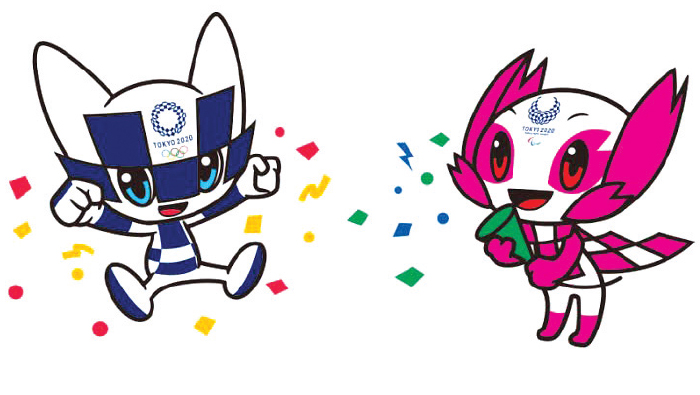
Tokyo: Olympics mascot Miraitowa and the Paralympics mascot Someity will be everywhere during the Tokyo Olympic Games, which run from July 23 to August 8.
Miraitowa stands for “future” (mirai) and “eternity” (towa). Japanese schoolchildren chose the design by artist Ryo Taniguchi. It combines futuristic and traditional Japanese manga styles.
Munich 1972: Waldi
It all started with Waldi the dachshund, the first-ever Olympic mascot. He debuted at the 1972 summer games in Munich. Designed by the famous designer Otl Aicher, the colorful little canine stood for endurance, skill and perseverance — important qualities for any athlete.
Montreal 1976: Amik
Amik, the pudgy black beaver with the huge red sash, was the mascot at the 1976 Olympic Games in Montreal, Canada. He may not look like much of an athlete, but for Canadians, a beaver stands for hard work. Amik means beaver in Algonquin, a Native American language.
Moscow 1980: Misha
In 1980, Russia went for a cuddly mascot, the smiling brown bear Misha. The bear is Russia’s national animal. This one was designed by the Russian cartoonist and children’s book illustrator Viktor Chizhikov, who won international fame with Misha.
Los Angeles 1984: Sam
If the bear is typical of Russia and the dachshund of Germany — then the bald eagle is for the United States. Walt Disney’s Robert C. Moore gave Sam the Olympic Eagle a top hat and bow tie in the country’s national colours of red, white and blue. Some people felt the eagle looked more like a very different kind of bird, so the mascot was occasionally referred to as “Sam the chicken.”
Seoul 1988: Hodori
The mascot in the first Olympic Games in South Korea was a stylized smiling Amur tiger by the name of Hodori. Tigers are deeply rooted in Korean culture and mythology, standing for hospitality and friendliness. The cheerful little mascot wears a sangmo, a typical Korean hat, on his head. Its designer was Kim Hyun.
Barcelona 1992: Cobi
Reactions to Cobi, the official 1992 mascot, were initially mixed. While designer Javier Mariscal’s stylized creation was supposed to be reminiscent of a Pyrenean mountain dog, the German TAZ newspaper wrote that Cobi could just be another animal. Cobi was designed in cubist style to pay tribute to Spain’s great painter, Pablo Picasso.
Atlanta 1996: Izzy
Izzy was the first Olympic mascot that did not represent a typical national animal. The design by John Ryan shows a purely imaginary creature. Izzy’s name is derived from “Whatizit?” or “What is it?” and was chosen by children from the Olympic host city. The mascot became a marketing bestseller.
Sydney 2000: Olly,
Syd and Millie
In the year of the new millennium in Sydney, Olympic athletes had three lucky charms: Syd, a platypus; Millie, an echidna; and Olly, a kookaburra. The trio was designed by Matthew Hatton. They are all native to Australia and represent the elements of earth, air and water. The kangaroo and the koala were ruled out as mascots from the outset because they were considered too cliché.
Athens 2004:
Athena and Phoibos
For the 2004 Summer Olympics, Greece fittingly chose mascots that referred to antiquity. Athena and Phoibos, also the names of Greek gods, stood for light and music. Spyros Gogos’ design is reminiscent of Greek terracotta dolls from the archaic period of ancient Greece.
Beijing 2008: Beibei,
Jingjing, Huanhuan,
Yingying and Nini
For the 2008 games, China also went with several mascots: Beibei, the fish; Jingjing, the panda; Huanhuan, the Olympic fire; Yingying, a Tibetan antelope; and Nini, a swallow. The names of the five figures were derived from “Beijing huanying ni,” which means “Beijing welcomes you,” and their colours echoed the Olympic rings.
London 2012:
Wenlock und Mandeville
Four years later, London presented two amorphous steel art figures — a nod to the steel industry: Wenlock, for the Olympics, and Madeville, for the Paralympics. The yellow lights on their foreheads echo the lights on the roofs of London’s famous cabs. The eye, a camera, is meant to symbolize the leap into the digital age. They were designed by Iris, a London-based creative agency.
Rio 2016: Vinicius and Tom
Brazil’s Paralympics mascot Tom combines several plants, and represents Brazil’s flora. Olympic mascot Vinicius looks like a cross between monkey and wildcat, and represents Brazil’s fauna. An animated series featured the two characters. Their namesakes are the co-writers of Brazil’s 1962 bossa nova hit song, “The Girl from Ipanema.”